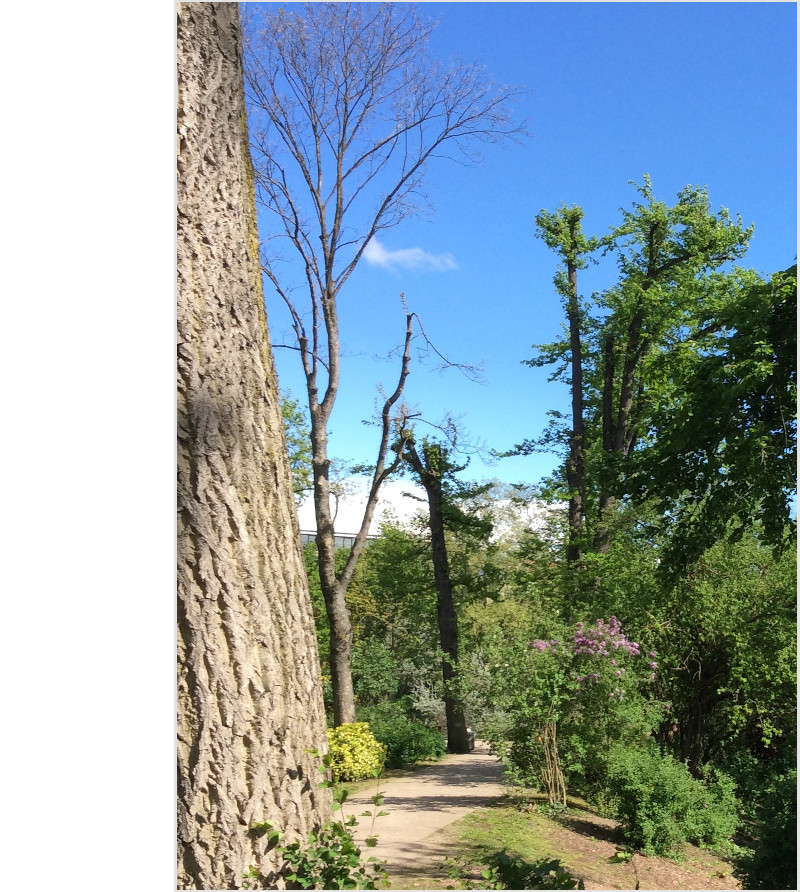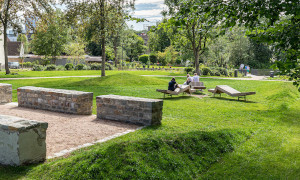Anticipating climate challenges in the planning process.
By Ehm Eike Ehrig
The epochal times in which mankind lives usually only become apparent in the retrospective of historiography. However, the changes to which we humans and our environment are currently exposed seem to be becoming clearer with increasing speed. For more and more people it is becoming clear that we have arrived in the age of climate change.
And for us professionals, too, the scope and significance of this realization are becoming clear in our everyday planning work. In the Werre floodplain (East Westphalia), for example, no trees may be planted with reference to a ten-thousand-year flood event. The justification is as factual as it is irritating if it is based on the assumption that the hundred-year and even the thousand-year flood event would become too probable with climate change for planning with tree planting to take place on such a flood quota.
Apart from such extreme flood expectations, spruces are dying in our parks and forests as a result of dry periods at a rate that is scarcely inferior to the drama of the death of elms about 80 to 100 years ago. Although spruces were often planted in unsuitable locations and were also monocultures in the forests, something extraordinary is happening here. - Apart from spruce, many other tree species are also in distress.
In 2014, for example, Storm Ela swept across Düsseldorf and the baroque park forest of Benrath Castle (1), with many beech trees falling victim to this weather event. Here, it can be argued that the beech forest stand had already reached the decay phase, and the storm hit a weakened stand. Nevertheless, all these explanations cannot hide the fact that the times when we could live in a temperate climate zone are obviously over.

Looking for possible opportunities among the climate risks
But how should we landscape architects respond to these accelerating climate change processes? The risks that have to be dealt with in open space planning are manifold. Both the animate structures of the woody plants and the undergrowth are affected as well as the inanimate structures of the paths, fastening surfaces, embankments, walls and bridges. In the future it will have to be carefully considered in project planning whether planners should use water-bound path surfaces even on short stretches with slight deviations from the FLL guideline of 7 % or 8 % or whether it is better not to do so. This is because the risks of wash-off and flooding are increasing in many places.
In the light of climate change, a reference after damage has occurred to the fact that this was a special weather phenomenon is unlikely to impress a judge and certainly not an insurance company, which for its part has long since applied different standards to the risks it insures. Alone, it will not move us forward socially to price and bemoan only the risks of climate change.
Without wishing to argue euphemistically, our profession, which is more qualified than almost any other to plan with foresight, should also look for possible opportunities among the climate risks. After all, what is landscape architecture but thriving optimism and a belief in life?
Planning a green paradise for increasingly overheated cities is becoming both more necessary and more difficult. For as climate change intensifies, so does the eutrophication crisis, which was already rampant before the EU Commission insisted on keeping groundwater clean before the ECJ and the effects of climate change became visible to anyone who cared to look. Nitrogen inputs from the air and from intensive human and animal use are massive and further exacerbate drought stress on trees in parks.
This is because with increased nitrogen concentrations in the soil, the permanent wilting point (PWP) decreases. In years of extremely dry summers like 2018 or 2019, this leads to accelerated dehydration of trees. The intracellular pressure (turgor pressure) drops to a critical level and the resilience of the wood is reduced, which can lead to increased heavy branch breakage or summer breakage if the weight of lower branch sections is high and perhaps poorly supplied by stand pressure.
Eutrophication is thus a "fire accelerant" for ecological resiliency challenged by climate change. The City of Minden's historic glacis has suffered from this very situation, losing many trees in the summer of 2019. A maintenance and development concept for the historic glacis woodlands (2), which has just been completed, could prevent the woody stands from becoming impoverished in species or even collapsing altogether in individual areas in the coming years.
Tree species diversification in the street space
It is an obvious fact that our landscape will change with the changing climate. Nevertheless, in many places there is little willingness to accept non-native trees in municipal open space planning. In this respect, the city of Düsseldorf is taking an exemplary, forward-looking approach to the issue of tree species diversification in road space with the aid of several alien tree species. The Düsseldorf street tree list (3) thus also serves to test woody plants suitable for climate change and encourages people to try out new things.
On the other hand, however, we often have municipal administrations that refuse to use non-native trees as street trees and also prescribe for private gardens when planting bids that only native species should be used. The only thing that helps here is to patiently educate people and to convince them with objective arguments. This is not easy when species are stipulated in development plans which, although native, would be less suitable than alien species from a climate change perspective.
In addition to all these aspects of planning, however, it is also important to critically question the planning process itself. As a member of the green sector and, moreover, of the conceptually thinking discipline of landscape architecture and landscape planning, we have a social role model function that must be fulfilled. Within society, our discipline should be the think tank for dealing with the consequences of climate change and develop intelligent climate adaptation strategies. Therefore, it would be beneficial to make our own work as CO2-neutral as possible and to think through and improve all office activities and work processes, from PC and server power consumption to mobility for construction site trips and other out-of-town appointments to paper consumption, in terms of greenhouse gas pollution.
Even though our industry may only have a marginal, almost negligible share in the emission of climate-damaging gases, it is still a matter of credibility and our own self-image, which we need not only for our own self-assurance, but also for the image that we as a specialist discipline credibly present to society. After all, if society is looking around for experts who are familiar with climate adaptation strategies and planning, that should be us!
(1) EHRIG, E.E. (2015): Gartendenkmalpflegerische Konzeption zur Wiederherstellung des orkangeschädigten Schlossparks Benrath. City of Düsseldorf. L-A-E Bielefeld
(2) EHRIG, E. E. 2019: Maintenance and development concept Glacis Minden. City of Minden, urban planning and environment. L-A-E Bielefeld
(3) STADT DÜSSELDORF 2016: Zukunftsbaumliste Düsseldorf. State capital Düsseldorf, Garden, Cemetery and Forestry Office. Düsseldorf
Author: Ehm Eike Ehrig, Landscape Architect bdla, L-A-E LandschaftsArchitekten Ehrig
- Latitude: 0
- Longitude: 0


